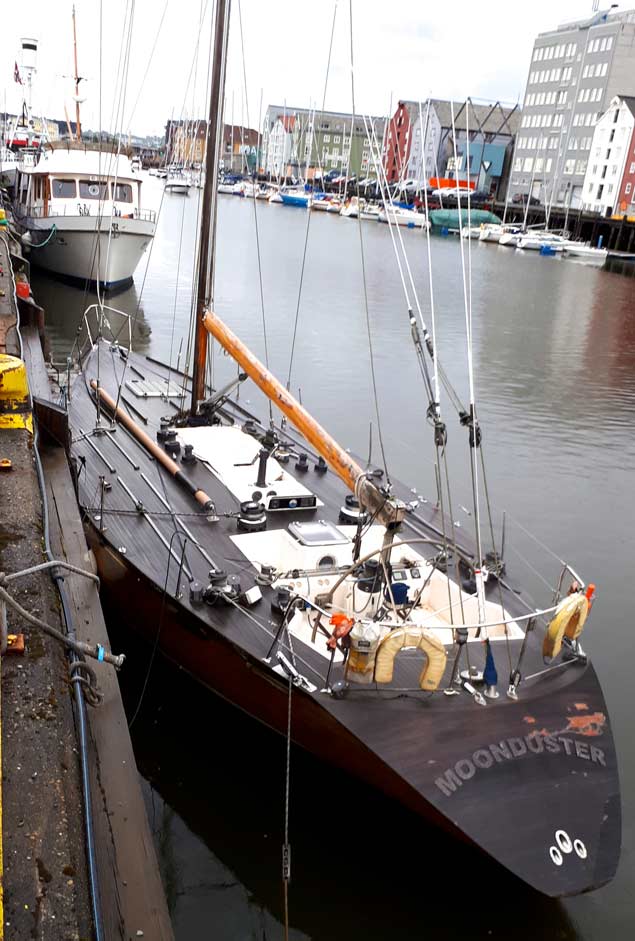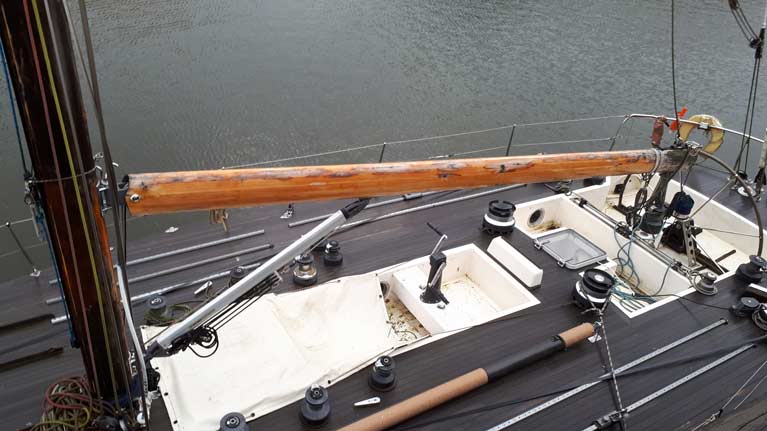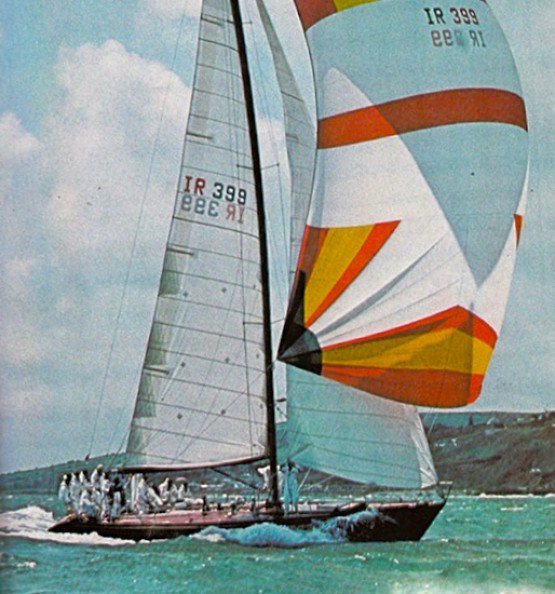As each year passes, it becomes increasingly difficult to explain to up-and-coming offshore racers just what “The Doyler and The Duster” meant to a whole generation of Irish sailors writes W M Nixon.
Crosshaven-built in 1981 and kitted out with sails from the new McWilliam loft just up the road, the majestic Moonduster was a one-off Frers 51 sloop which was our flagship, while the ever-enthusiastic Denis Doyle was our captain, our admiral, the great skipper who always went the extra mile – indeed, the extra thousand miles and more - to sail and race for Ireland, leading by example and winning many trophies along the way.
 Denis Doyle, the inspiration for more than one generation of Irish offshore sailors.
Denis Doyle, the inspiration for more than one generation of Irish offshore sailors.
When he died in the Autumn of 2001 – having completed his last Fastnet aboard Moonduster at the age of 81 back in August – it left a void, an empty gap so great that no-one really comprehended its enormity at the time. Yet as the months passed, it became clear that nobody in Ireland could reasonably be expected to take over Moonduster and everything which that entailed, for the pace and dedication with which Denis Doyle campaigned Moonduster – supported by his indomitable wife Mary – was far beyond the capacities of even the most talented Irish skipper.
So when in due course Moonduster was sold away to a new project for an offshore sailing school based in Trondheim well north along the coast of Norway, it was a relief in Crosshaven and throughout Ireland. The splendid yacht seemed to have found a new purpose in life which – if done properly – was worthy of her. And for a while all seemed well, with the occasional photo circulating of Moonduster fulfilling her new role off the mountainous Norwegian coast with that same unmistakable style.
 Moonduster in action off Trondheim during her early years in Norway
Moonduster in action off Trondheim during her early years in Norway
Few - if any - remember precisely when there started to be disturbing hints that all was not well in Trondheim. A boatyard fire destroyed another substantial offshore racer belonging to the school, but the word was that Moonduster was safe. There was silence for a while, then two or three or maybe more years later, photos came back showing Moonduster still in Trondheim, but now in a neglected and unused state.
However, there were hopeful hints that a syndicate of concerned former Moonduster sailors was being assembled to remedy the situation. Yet nothing seems to have come of it, for her ownership is an increasingly complicated matter. And then at the end of June this year an email arrived from Mike Foreman, who was cruising in Norway with his Nich 35 Blue Tarn, and in Trondheim he had happened – with some shock – on Moonduster in woeful condition against a rather insalubrious quayside in a corner of the harbour.
 Moonduster glimpsed from a distance in Trondheim at the end of June. Photo Michael Foreman
Moonduster glimpsed from a distance in Trondheim at the end of June. Photo Michael Foreman
 Only a ghost of her former herself – were it not for the name on the transom, we’d hardly recognize her. Photo: Michael Foreman
Only a ghost of her former herself – were it not for the name on the transom, we’d hardly recognize her. Photo: Michael Foreman Moonduster, Trondheim, June 2019 – somewhere in there is one of the most sophisticated examples of wooden boat construction ever built in Ireland. Photo: Michael Foreman
Moonduster, Trondheim, June 2019 – somewhere in there is one of the most sophisticated examples of wooden boat construction ever built in Ireland. Photo: Michael Foreman
Mike Foreman spent his boyhood on the shores of Ballyholme Bay on Belfast Lough, as I did too. But while I simply wanted to mess about in boats for sport in cruising and racing, he seriously wished to become a professional fisherman and ended up based in Carradale in western Scotland, an attractive little fishing port about halfway up Kilbrannan Sound inside Arran, on the Kintyre coast.
There, he was owner-skipper of three fishing boats in succession, the middle one being the 1957-built 56ft Glendalough from Tyrrell of Arklow, which was in Portavogie ownership by the time he bought her in the early 1980s.
 The 56ft Glendalough, built by Tyrrell of Arklow in 1957, which Michael Foreman fished from Carradale for five years in the 1980s
The 56ft Glendalough, built by Tyrrell of Arklow in 1957, which Michael Foreman fished from Carradale for five years in the 1980s
He fished west of Kintyre and around Gigha in summer, and up the Clyde in winter, mostly at night past Rothesay and beyond. It’s thought-provoking to think of the yacht-owning burghers of Largs comfortable in their beds of a January night as this Ballyholme boy went slowly past their darkened windows, out in the Firth in the deep cold of winter in search of a good catch….
Tough it may have been at times, sometimes very tough, but he never lost his love of seafaring, and when he retired from the fishing he bought himself a 28ft Twister class sloop for a spot of summer cruising, and then followed her with the Nicholson 35 Blue Tarn, with which he did an Atlantic circuit cruise in 2008-2009.
 Mike Foreman’s Nich 35 Blue Tarn off Bequia in the Caribbean in 2009
Mike Foreman’s Nich 35 Blue Tarn off Bequia in the Caribbean in 2009
It was while cruising Blue Tarn towards the Lofoten Isles in Arctic Norway this past summer that he put into Trondheim in search of a replacement part for a broken section of his wind-vane. It emerged that its delivery would take all of six days, so he got to know Trondheim rather better than he would have liked, for it rained every day. But in one of his walks around the town and harbour, he came upon Moonduster, and she’s not a welcome sight for anyone who cares as much about boats as Mike Foreman.
 Moonduster 2019 – a sad state of affairs. Photo: Michael Foreman
Moonduster 2019 – a sad state of affairs. Photo: Michael Foreman
The thought of the images he sent was pushed to the back of the mind while we went through the busy season of 2019. But now here we are, nearly three months later, and if there’s any word on the grapevine about hopeful news of Moonduster, it certainly hasn’t percolated through to those who would know in Crosshaven.
Mike Foreman’s photos speak for themselves. Moonduster needs something to be done, but the estimate from a highly qualified expert who knew her well says that we’re talking about a project of at least €0.5 million. And when you have restored her, what will you do with her?
As the restored Ilen of Limerick has shown, such projects need a purpose beyond simply restoring them to seagoing conditions. Thus Ilen’s cultural-exchange Salmons Wake voyage to Greenland and her subsequent work in the Sailing into Wellness programme in Kinsale add an extra valuable and meaningful dimension to her new way of life.
 Historic boats with a new purpose in life – Ilen and Killary Flyer in Nuuk in Greenland in August, Paddy Barry on Ilen (far left), Jamie Young on bow of Killary Flyer (right)
Historic boats with a new purpose in life – Ilen and Killary Flyer in Nuuk in Greenland in August, Paddy Barry on Ilen (far left), Jamie Young on bow of Killary Flyer (right)
And ironically, it was while she was in Greenland that Ilen met up with another Irish-based boat which, like Moonduster, is a former top-line international offshore racer. This was Jamie Young’s Frers 49 Killary Flyer from the Killary Adventure Centre in Connacht, a boat which - as Hesperia and before that as Noryema IX - was very much a successful fixture on the national and international racing scene.
But Killary Flyer is built of aluminium alloy, which means she can confidently go into the ice, and every year she spends prolonged periods in Greenland waters on expedition voyages – so much so that this year we secretly expected her to become the first yacht to circumnavigate Greenland as the ice recedes, but it seems that’s something for another year, as she was southward bound when Ilen met her in Nuuk.
In contrast to Killary Flyer’s robust alloy hull, Moonduster is timber finished in multi-skin mahogany using the WEST system. Superbly strong, but definitely not suitable for ice-bashing. Nevertheless Moonduster’s construction – with Dick Leonard in charge on the build floor in Crosshaven Boatyard and Tony Castro project managing to report to all concerned – was quite something, as her two wafer-like inner diagonal skins were mahogany, then she’d a skin of carbon, then she’d two more diagonal skins of mahogany, then another skin of carbon, and then two final skins of mahogany, the outer one being horizontal.
It sounds as if it might have been ultimately quite heavy, yet on the contrary, it was exceptionally light. So much so, in fact, that on the night before the first Admirals Cup Selection Trials Race in mid-May 1981, Tony Castro, Dick Leonard, The Doyler himself and others were sweating in the bilges of Moonduster trying to get enough lead in place to bring her rating down to the AC maximum of 40ft while still complying with all RORC and measurement rules requirements. They finally succeed a few minutes after 2200 hrs, and next morning Moonduster made her racing debut in that glorious style which imprinted itself on Irish sailing consciousness for two wonderful decades.
 Moonduster makes her racing debut in May 1981. Photo: W M Nixon
Moonduster makes her racing debut in May 1981. Photo: W M Nixon
So now what’s to be done? I simply don’t know. Perhaps there has been a miracle in Trondheim since June that no-one has yet heard about. We can only hope that something good happens, for 1981 was a very special year for maritime Ireland. The new Asgard II was commissioned for the first time in March 1981. And then Moonduster made her debut in May. It would be very sad if we were to lose both of them.






























































